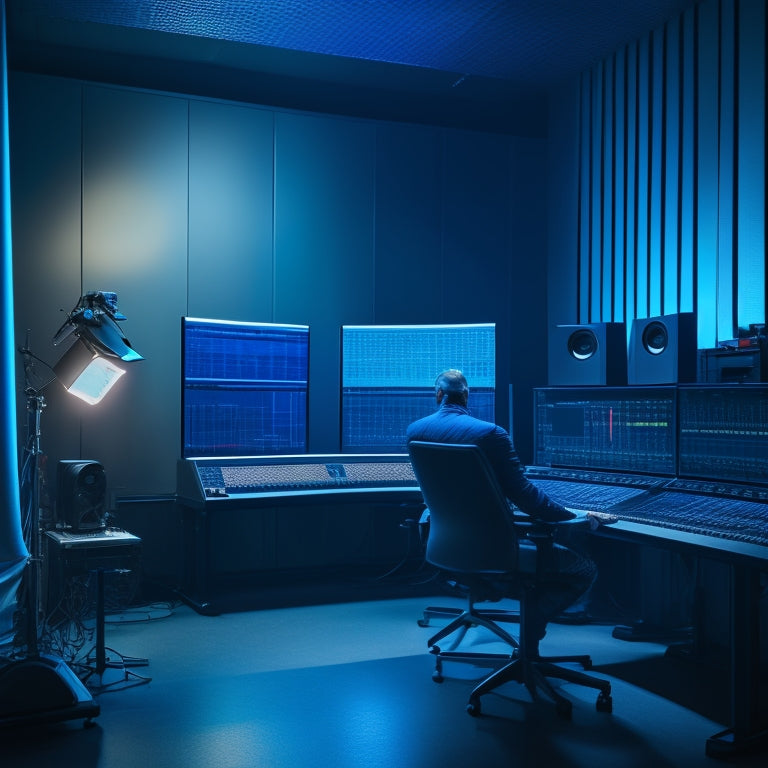
Editing Music for Competition-Worthy Tracks
Share
You'll spend more time editing your track than producing it, so expert editing is essential for competition success. Start by grasping music editing fundamentals, including destructive vs. non-destructive editing and audio theory principles. Then, choose editing software that fits your workflow and sound quality goals. A well-structured track with tempo changes, emotional cues, and balanced instrument levels will engage listeners. Optimize EQ settings, add depth with FX, and edit for dynamic rhythm. Finally, refine your track's creative vision and soundscaping. With these skills, you'll be on your way to crafting a competition-worthy track that truly stands out - but that's just the beginning.
Key Takeaways
• Establish a clear track structure with seamless section shifts and mood changes to engage listeners and create a cohesive mix.
• Balance instrument levels to maintain frequency clarity, dynamic range, and individual sonic space for each instrument, ensuring a polished sound.
• Optimize EQ settings by prioritizing midrange frequencies, avoiding extreme adjustments, and making subtle changes for a balanced sound.
• Utilize tempo changes strategically to build energy and tension, and balance them for a dynamic yet cohesive track.
• Add emotional depth with FX techniques like spatialization, reverb, and distortion to craft a sonic landscape that resonates with listeners.
Understanding Music Editing Fundamentals
When delving into editing music for competition-worthy tracks, you'll need to grasp the basics of music editing fundamentals, including the difference between destructive and non-destructive editing. Understanding this concept is vital for maintaining the integrity of your audio files and ensuring creative freedom throughout the editing process.
Destructive editing involves directly altering the original audio file, which can lead to irreversible changes and potential data loss. On the other hand, non-destructive editing allows you to make changes to a copy of the original file, preserving the original data and ensuring safety.
To make informed editing decisions, having a solid foundation in audio theory is crucial. This includes understanding concepts such as frequency response, dynamic range, and signal flow. By applying these principles, you'll be able to make targeted edits that enhance the overall sound quality of your track.
With a strong grasp of music editing fundamentals, you'll be able to work efficiently and confidently, enabling your creative freedom to produce high-quality, competition-worthy tracks.
Choosing the Right Editing Software
With your music editing fundamentals in place, you're now ready to harness the power of editing software, an important tool in your quest for competition-worthy tracks.
Choosing the right software is vital, as it can greatly impact your workflow and overall sound quality. When selecting an editing software, consider the software capabilities that align with your creative vision. Do you need advanced effects processing, or perhaps robust MIDI editing features? Make a list of your must-haves and nice-to-haves to guide your search.
Next, assess the user interface and its usability. A well-designed interface can streamline your workflow, while a cluttered or confusing one can hinder your creativity. Look for software with a customizable workspace, intuitive navigation, and responsive controls.
Some popular options include Ableton Live, Logic Pro, and FL Studio. Each has its strengths and weaknesses, so it's important to try before you buy. Take advantage of free trials or demos to get a feel for the software that best suits your needs.
Creating a Compelling Track Structure
You'll need to architect a clear, coherent track structure to convey your artistic vision and keep listeners engaged. A well-structured track is essential to maintaining listener interest and conveying your artistic message. To achieve this, focus on crafting seamless section shifts that guide the listener through your track. These shifts should be smooth, logical, and deliberate, avoiding abrupt changes that disrupt the flow.
Mood changes are also vital in creating a compelling track structure. By strategically placing contrasting sections, you can create tension and release, adding depth and emotion to your music. For example, a sudden shift from a calm atmosphere to an intense drop can be incredibly effective in engaging the listener.
When executed correctly, these mood changes can elevate your track from ordinary to exceptional. Remember, a well-structured track isn't just about the individual elements, but how they work together to create a cohesive and engaging listening experience. By paying attention to section shifts and mood changes, you'll be well on your way to crafting a competition-worthy track that leaves a lasting impression.
Building Energy With Tempo Changes
By strategically implementing tempo changes, you can inject energy into your track and create a sense of tension and release, taking your listeners on a dynamic ride. This technique allows you to build anticipation, create surprises, and add emotional depth to your music.
To achieve this, try using pulse acceleration, where you gradually increase the tempo to create a sense of urgency. This can be particularly effective in building towards a climax or drop.
Alternatively, try inserting rhythmic surprises, such as sudden tempo shifts or time signature changes, to add an element of unpredictability to your track. These surprises can create a sense of excitement and keep your listeners engaged.
When using tempo changes, it's crucial to balance them with moments of stability to avoid overwhelming your listeners. By striking the right balance, you can craft a track that's both dynamic and cohesive, keeping your audience engaged and enthusiastic for more.
Crafting Effective Music Cues
As you craft effective music cues, you'll want to focus on creating emotional triggers that resonate with your audience.
You'll need to build tension points that expertly ratchet up the emotional intensity, and then enhance emotional peaks that leave a lasting impact.
Creating Emotional Triggers
To evoke a powerful emotional response from your audience, craft music cues that strategically coincide with pivotal moments in your track, amplifying the emotional impact of each scene. By doing so, you'll create emotional triggers that resonate with your listeners, making your track more engaging and memorable.
To craft effective emotional triggers, focus on creating Mood Memories that evoke a specific emotional response. This can be achieved by using Sonic Landscapes that transport your listeners to a particular time and place. For instance, a nostalgic melody can evoke feelings of nostalgia, while a dark, ominous tone can create a sense of foreboding.
When creating emotional triggers, consider the context in which they'll be used. Will they be used to heighten tension or provide relief? By carefully crafting your music cues, you'll be able to evoke a powerful emotional response from your audience, making your track more impactful and memorable.
Building Tension Points
You'll strategically place music cues to build tension points, heightening the emotional impact of pivotal moments in your track and drawing your audience in. By crafting effective music cues, you'll create an immersive experience that keeps listeners engaged.
Building tension points is essential in creating a compelling narrative arc in your music.
To achieve this, focus on the following key elements:
-
Tension Arcs: Create a gradual increase in tension leading up to the climax moment, using techniques like rising melodies, intensifying rhythms, or growing instrumentation.
-
Climax Moments: Identify the peak emotional moments in your track and amplify their impact with dramatic changes in melody, harmony, or rhythm.
-
Contrast and Release: Balance tension points with moments of release, providing a sense of resolution and contrast to create a dynamic listening experience.
Enhancing Emotional Peaks
By strategically crafting music cues, you're able to pinpoint and amplify the emotional peaks in your track, elevating the overall impact of your narrative arc. Effective music cues create an emotional resonance that resonates with your audience, drawing them deeper into your sonic landscapes. To craft impactful cues, focus on the emotional intensity of your track, identifying moments that evoke strong emotions in your listeners.
| Cue Type | Emotional Intensity | Sonic Techniques |
|---|---|---|
| Climactic Peak | High | Orchestral swells, soaring melodies |
| Emotional Valley | Low | Minimalist textures, ambient pads |
| Tension Build | Medium-High | Percussive accents, dissonant harmonies |
| Release | Medium-Low | Legato melodies, soothing harmonies |
Mixing Music for Clear Audio
When you're mixing music for clear audio, you'll need to focus on balancing instrument levels to create a cohesive sound.
You'll also need to optimize your EQ settings to guarantee each instrument occupies its own frequency range.
Balancing Instrument Levels
Adjusting instrument levels is essential for achieving a balanced mix, as it enables each element to occupy its own sonic space and project a clear, defined sound. When you balance instrument levels, you create a sonic hierarchy, where each instrument has its own place in the frequency spectrum. This clarity is vital for competition-worthy tracks.
To achieve this balance, focus on the following key aspects:
-
Establish a clear frequency clarity: Make sure each instrument occupies a distinct frequency range, avoiding frequency clashes and masking.
-
Create a sonic hierarchy: Organize instruments in a hierarchical structure, with prominent elements taking center stage and supporting elements providing depth.
-
Maintain dynamic range: Balance instrument levels to create a sense of dynamic range, with quiet moments contrasting with louder sections.
Optimizing EQ Settings
You'll sculpt a clear and defined sound by strategically applying EQ settings to individual tracks, allowing each instrument to cut through the mix with precision. To achieve this, focus on frequency balance, guaranteeing that each element occupies its unique sonic space.
Start by identifying the fundamental frequencies of each instrument, then adjust your EQ settings to enhance or attenuate specific frequencies as needed.
When tone shaping, prioritize the midrange frequencies (200 Hz - 800 Hz), as these have the greatest impact on the overall sound. Boosting or cutting in this range can dramatically alter the tone of an instrument, making it sit well in the mix or stick out like a sore thumb.
Be cautious when applying extreme EQ adjustments, as these can introduce unwanted resonances or harshness. Instead, make subtle adjustments, A/Bing your changes to guarantee a balanced and polished sound.
Adding Emotional Depth With FX
By strategically inserting FX into your mix, you can breathe life into an otherwise flat soundscape, evoking emotions and drawing listeners deeper into your music. This is where the art of sound design comes into play, allowing you to craft sonic landscapes that transport your audience to new dimensions.
To add emotional depth with FX, consider the following techniques:
-
Spatialization techniques: Use panning, depth, and width to create a sense of space, making your mix feel more immersive and engaging.
-
Reverb and delay: Add ambiance and distance to your sounds, creating a sense of distance and atmosphere.
-
Distortion and saturation: Introduce subtle imperfections to add character and warmth to your sounds, making them feel more organic and human.
Editing for Dynamic Rhythm
With your soundscape now rich in emotional depth, it's time to focus on editing for dynamic rhythm, where you'll craft a pulsing energy that propels your track forward. You'll create a sense of rhythmic tension by balancing contrasting elements, making your track more engaging and competitive.
| Element | Technique | Effect |
|---|---|---|
| Drum Pattern | Alternating snare and kick | Creates a sense of urgency |
| Percussion | Introduce polyrhythmic interest | Adds complexity and tension |
| Synth Riff | Use syncopation and accents | Emphasizes key rhythmic points |
Finalizing Your Competition Track
As you put the finishing touches on your competition track, scrutinize every element to guarantee a cohesive, high-impact mix that showcases your artistic vision. This is your last chance to refine your creative vision and make sure it translates to your listeners. Take a step back, and objectively assess your track's overall soundscaping.
Here are some final checks to ponder:
-
Balance and contrast: Make sure your track has a clear structure, with balanced levels and contrasting elements to keep the listener engaged.
-
Frequency management: Double-check your EQ settings to avoid frequency clashes and establish a clear, polished sound.
-
Space and depth: Utilize spatial effects and depth techniques to create an immersive listening experience.
Frequently Asked Questions
How Do I Maintain Creative Vision Amidst Editing Revisions?
"When you're stuck in the weeds, don't lose sight of the forest - stay true to your artistic vision. Hold on to visionary clarity, safeguarding creative integrity amidst editing revisions, ensuring your artistic freedom remains uncompromised."
Can I Edit Music on a Laptop Without an External Sound Card?
You can edit music on a laptop without an external sound card, but be aware of laptop limitations; built-in audio interfaces may compromise sound quality, affecting your portable production.
What's the Ideal Sample Rate for Professional Music Editing?
'Are you prepared to access professional-grade audio? For peak Audio Fidelity, you'll want to aim for a sample rate of 96 kHz or higher, meeting Studio Standards for crisp, detailed sound, ensuring your tracks shine.'
Do I Need to Master My Track for Music Competitions?
'When submitting to music competitions, you'll want to make sure your track is competition-ready. Yes, you need to master your track, focusing on Mastering Essentials, to achieve Audio Optimization and a professional Sonic Polish, giving you a competitive edge.'
Can I Use Royalty-Free Samples in Competition-Worthy Tracks?
When using royalty-free samples, you'll still need to guarantee Sample Clearance and comply with Music Licensing terms to avoid copyright issues, so carefully review the licensing agreements to guarantee you're safe to compete.
Related Posts
-

5 Essential Tips for Online Dance Makeup Success
You're about to discover the secrets to a thriving online dance makeup presence. First, establish a strong online fou...
-

7 Comfortable Dance Shoes to Keep You Moving
When you're searching for comfortable dance shoes, look for options that offer support, cushioning, and flexibility. ...
-

Exclusive Crafting Files: Dance Mom Delight
Dance Mom Delight offers a wide collection of exclusive crafting files, providing users with a diverse range of digit...


